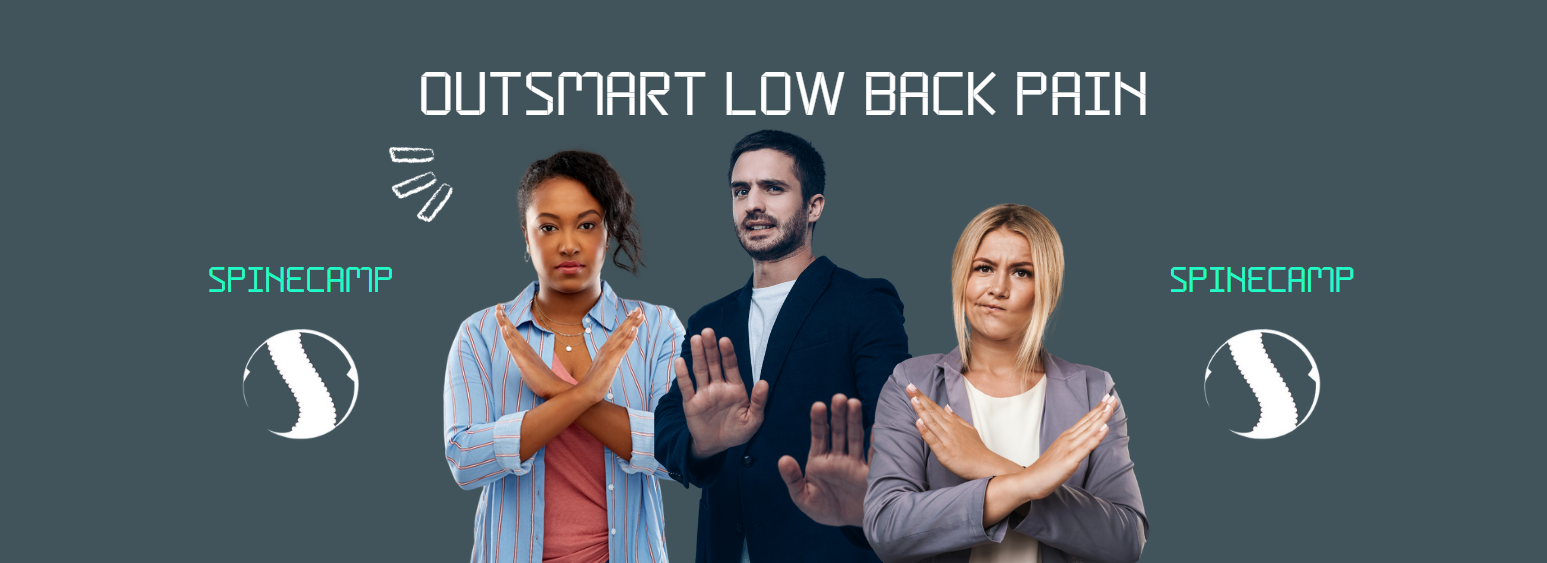Opioid medications continue to be commonly prescribed for chronic low back pain in the US despite limited evidence of effectiveness, high costs, and serious health risks. (1, 2)
In fact, in the United States, opioid prescriptions are now 3 times higher than in 1999, 4 times more than the prescription rate in Europe, and 12 times higher as compared to opioid use for chronic low back pain in Portugal. (3, 4)
A recent study, published in Oct. 2019, about opioid use for chronic low back pain in the United States revealed the following: (5)
Opioid analgesics were the most commonly used medication, taken within the past 30 days, by 18.8% of working-age Americans with chronic low back pain.
The average duration of opioid analgesic use for those with chronic low back pain was 702 days.
76.9% of current opioid users with chronic low back pain reported taking opioids for 1 year or longer.
9.8% of Americans with chronic low back pain used an opioid with acetaminophen, accounting for over half of the reported opioids and virtually all reported acetaminophen in this population.
Opioid use was disproportionately higher among 40–49 year-olds, African Americans, and adults with lower levels of education.
The trends noted above are alarming for several reasons.
First, and foremost, there is no evidence for the benefits of long-term opioids greater than 6 months in chronic non-cancer pain (6) In fact, several research papers have cast doubt on the benefit of opioid medication for short term, non-cancer pain, and others have found them to be no better than routine NSAID medications or placebo. (7 ,8)
Additionally, you will recall that opioids are commonly prescribed with acetaminophen. This combination has become a main cause of acetaminophen overdose (leading to sudden liver failure) and accounts for the most analgesic-related emergency department visits nationally. (9)
Even more important that what is mentioned above, is the physical and financial toll that opioid use puts on our society. Consider the following:
The Centers for Disease Control and Prevention estimates that the total "economic burden" of prescription opioid misuse alone in the United States is $78.5 billion a year, including the costs of healthcare, lost productivity, addiction treatment, and criminal justice involvement. (10)
Roughly 21 to 29 percent of patients prescribed opioids for chronic pain misuse them and between 8-12 % of these people develop an opioid use disorder. (11)
An estimated 4 to 6 percent who misuse prescription opioids transition to heroin. (12, 13)
Opioids contribute to more than 10,000 deaths per year (7)
It has also been shown that, paradoxically, the use of opioid medication can lead to a worsening of the condition it is supposed to help. The term used for this is “opioid induced hyperalgesia” meaning that certain patients can experience an increased sensitivity to pain because of taking opioids. This can occur in as little as one month after starting the medication. (17, 18)
It is somewhat understandable that many people with low back pain will turn to opioids. This is often because other medications they have tried have had little effect.
For example, a systemic review of NSAIDs found them to be only marginally better than a placebo, resulting in a reduction of pain intensity of only 3-4 on a 100-point scale (14)
The American College of Physicians most recent guidelines, published in the Annals of Internal Medicine state: (15)
“For treatment of chronic low back pain, clinicians should select therapies that have the fewest harms and lowest costs because there were no clear comparative advantages for most treatments compared with one another. Clinicians should avoid prescribing costly therapies; those with substantial potential harms, such as long-term opioids (which can be associated with addiction and accidental overdose); and pharmacologic therapies that were not shown to be effective, such as tricyclic antidepressants and selective serotonin reuptake inhibitors”
Also, as a result of their research, they offered the following 3 main recommendations:
Recommendation 1:
Given that most patients with acute or subacute low back pain improve over time regardless of treatment, clinicians and patients should select nonpharmacologic treatment with superficial heat (moderate-quality evidence), massage, acupuncture, or spinal manipulation (low-quality evidence). If pharmacologic treatment is desired, clinicians and patients should select nonsteroidal anti-inflammatory drugs or skeletal muscle relaxants (moderate-quality evidence). (Grade: strong recommendation)
Recommendation 2:
For patients with chronic low back pain, clinicians and patients should initially select nonpharmacologic treatment with exercise, multidisciplinary rehabilitation, acupuncture, mindfulness-based stress reduction (moderate-quality evidence), tai chi, yoga, motor control exercise, progressive relaxation, electromyography biofeedback, low-level laser therapy, operant therapy, cognitive behavioral therapy, or spinal manipulation (low-quality evidence). (Grade: strong recommendation)
Recommendation 3:
In patients with chronic low back pain who have had an inadequate response to nonpharmacologic therapy, clinicians and patients should consider pharmacologic treatment with nonsteroidal anti-inflammatory drugs as first-line therapy, or tramadol or duloxetine as second-line therapy. Clinicians should only consider opioids as an option in patients who have failed the aforementioned treatments and only if the potential benefits outweigh the risks for individual patients and after a discussion of known risks and realistic benefits with patients. (Grade: weak recommendation, moderate-quality evidence)
The article mentioned above is one that any clinician, or any individual, suffering from low back pain should be familiar with.
Unfortunately, research has shown that too many clinicians do NOT practice according to these scientifically- based recommendations which lead to needless harm and expense. (16)
Getting back specifically to opioids for low back pain, one of the authors of the most recent guidelines stated:
“Physicians should consider opioids as a last option for treatment and only in patients who have failed other therapies, as they are associated with substantial harms, including the risk of addiction or accidental overdose,” (15)
I have already mentioned one possible reason for opioid use, despite the numerous potential problems they cause, and their questionable effectiveness. That is, that people dealing with low back pain often find little relief with other types of medications they have tried.
Other possible explanations for overreliance on opioids could be due to lack of resources for safer pain management alternatives. Nonpharmacologic pain management approaches are frequently not covered by health insurance, leaving low back pain patients without access to some of the most widely recommended non-pharmacologic treatment options. (19)
Additionally, patients are often not appropriately informed about the low efficacy and high risk of side effects with opioid use for low back pain. (20)
In closing, it is understandable why people suffering with low back pain want to find relief. And, it is difficult for those not suffering with it to recognize the negative impact that it has on not only a person’s body, but also their mind. But, the use of opioids warrants strong caution because of their questionable effectiveness and the possibility of them leading to bigger problems that are even more difficult to treat.
If you, or someone you know, are currently taking opioid medication, there are tools that help to asses the risk of harm, such as addiction, diversion, suicidality etc.
Below are some links to helpful online resources
RESOURCES
Opioid Risk Assessment Tool: (Takes 1 minute to complete) CLICK HERE
NIH Opiod Crisis Information: CLICK HERE
American College of Physicians Low Back Pain Treatment Guidelines. CLICK HERE
World Health Organization Information Sheet on Opioid Abuse. CLICK HERE
Thank You.
Dr. Ronald D. Fudala (RDF-10)
References
1. Vogt MT, Kwoh CK, Cope DK, Osial TA, Culyba M, Starz TW. Analgesic usage for low back pain: impact on health care costs and service use. Spine. 2005; 30:1075–81.
2. Martin BI, Deyo RA, Mirza SK, Turner JA, Comstock BA, Hollingworth W, Sullivan SD. Expenditures and health status among adults with back and neck problems. JAMA. 2008; 299:656–64.
3. Guy GP, Zhang K, Bohm MK, Losby J, Lewis B, Young R, Murphy LB, Dowell D. Vital Signs: Changes in Opioid Prescribing in the United States, 2006–2015. MMWR Morb Mortal Wkly Rep. 2017; 66:697–704.
4. Gouveia N, Rodrigues A, Ramiro S, Eusébio M, Machado PM, Canhão H, Branco JC. The Use of Analgesic and Other Pain-Relief Drugs to Manage Chronic Low Back Pain: Results from a National Survey. Pain Pract. 2016
5. Dr. Anna Shmagel, MD, MSc et al. Prescription medication use among community-based US adults with chronic low back pain: a cross-sectional population based study. J Pain . 2018 October; 19(10): 1104–111
6. Noble M, Treadwell JR, Tregear SJ, Coates VH, Wiffen PJ, Akafomo C, Schoelles KM, Chou R. The Cochrane Collaboration. Cochrane Database of Systematic Reviews [Internet]. Chichester, UK: John Wiley & Sons, Ltd; 2010. Long-term opioid management for chronic noncancer pain. [cited 2017 Mar 8
7. Berthelot J-M, Darrieutort-Lafitte C, Le Goff B, Maugars Y. Strong opioids for noncancer pain due to musculoskeletal diseases: Not more effective than acetaminophen or NSAIDs. Joint Bone Spine. 2015; 82:397–401
8. Khoromi S, Cui L, Nackers L, Max MB. Morphine, nortriptyline and their combination vs. placebo in patients with chronic lumbar root pain. Pain. 2007; 130:66–75.
9. Willy M, Kelly JP, Nourjah P, Kaufman DW, Budnitz DS, Staffa J. Emergency department visits attributed to selected analgesics, United States, 2004–2005. Pharmacoepidem Drug Safe. 2009; 18:188–95
10. Florence CS, Zhou C, Luo F, Xu L. The Economic Burden of Prescription Opioid Overdose, Abuse, and Dependence in the United States, 2013. Med Care. 2016;54(10):901-906.
11. Vowles KE, McEntee ML, Julnes PS, Frohe T, Ney JP, van der Goes DN. Rates of opiod misuse, abuse, and addiction in chronic pain: a systematic review and data synthesis. Pain. 2015;156(4):569-576
12. Muhuri PK, Gfroerer JC, Davies MC. Associations of Nonmedical Pain Reliever Use and Initiation of Heroin Use in the United States. CBHSQ Data Rev. August 2013
13. Carlson RG, Nahhas RW, Martins SS, Daniulaityte R. Predictors of transition to heroin use among initially non-opioid dependent illicit pharmaceutical opioid users: A natural history study. Drug Alcohol Depend. 2016;160:127-134.
14. Enthoven WT1, Roelofs PD, Deyo RA, van Tulder MW, Koes BW Non-steroidal anti-inflammatory drugs for chronic low back pain. Cochrane Database Syst Rev. 2016 Feb
15. Amir Qaseem, MD, PhD, MHA; Timothy J. Wilt, MD, MPH; Robert M. McLean, MD; Mary Ann Forciea, MD; for the Clinical Guidelines Committee of the American College of Physicians. Noninvasive Treatments for Acute, Subacute, and Chronic Low back Pain: A Clinical Practice Guideline From the American College of Physicians. Ann of Intern Med. 2017;166(7):514-530
16. John N. Mafi, M.D et al. Worsening Trends in the Management and Treatment of Back Pain JAMA Intern Med. 2013 September 23; 173(17): 1573–1581
17. Chu LF, D’Arcy N, Brady C, Zamora AK, Young CA, Kim JE, Clemenson AM, Angst MS, Clark JD. Analgesic tolerance without demonstrable opioid-induced hyperalgesia: a double-blinded, randomized, placebo-controlled trial of sustained-release morphine for treatment of chronic non-radicular low-back pain. Pain. 2012
18. Wm H, TjLCT. Opioid-induced hyperalgesia in community-dwelling adults with chronic pain, Opioid-Induced Hyperalgesia in Community-Dwelling Adults with Chronic Pain. Pain. 2015; 156:1145–52.
19. Weeks J. Influential U.S. Medical Organizations Call for Insurance Coverage of Non-Pharmacologic Approaches to Pain. J Altern Complement Med. 2016; 22:947–9
20. McCarthy DM, Cameron KA, King JP, Mullen RJ, Bailey SC, Jacobson KL, Di Francesco L, Davis TC, Parker RM, Wolf MS. Patient Recall of Health Care Provider Counseling for Opioid Acetaminophen Prescriptions. Pain Med. 2014; 15:1750–6

